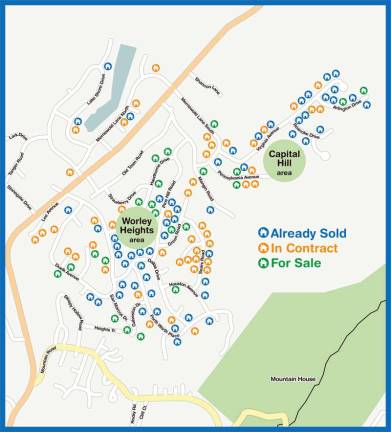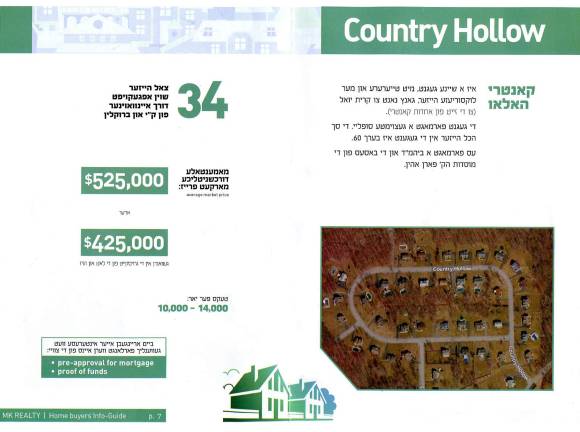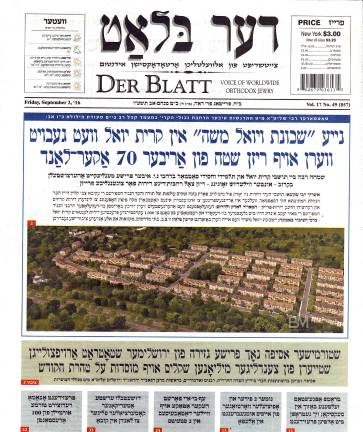The KJ overflow



By Bob Quinn
MONROE — It is a common belief that the annexation of land from the Town of Monroe into the Village of Kiryas Joel will be tied up in court for years.
But that notion fails to acknowledge the drive to expand, to house, to give birth to a community determined to grow, whether within the village or outside its borders.
Or what one official called “the KJ overflow.”
The KJ overflow is described in a “Home Buyers Info-Guide” distributed in Kiryas Joel and in Brooklyn by a real estate firm that caters to Hasidic families. It recommends that prospective buyers look outside Kiryas Joel to nearby communities where they will find large houses “for much lower prices.”
The KJ overflow can also be seen in advertisements and articles in newspapers published in Kiryas Joel for at least the last two months. The advertisements tout the purchases of homes in Woodbury and Blooming Grove, reporting how many have been purchased, how many are in contract and how many remain on the market.
And just last week, an article in the Sept. 2 edition of “Der Blatt,” a publication that describes itself as the “Voice of Worldwide Orthodox Jewry,” reported plans to build as many 1,500 housing units on the last undeveloped parcel in Kiryas Joel off Nininger Road, across from the State Police Barracks in Monroe.
Throw into this mix the five developments in the Town of Monroe that are temporarily held at bay because of the town’s building moratorium. And then there’s the proposed 566-home subdivision at the Lake Anne Country Club in Blooming Grove, just east of where Clove Road merges with Route 208.
The numbers grow. Concerns, too. What about water? What about sewer? What about traffic? What about politics? And what about the school districts?
What has become clear now in the year since the Monroe Town Board voted 4-1 to support the annexation of 164 acres into Kiryas Joel is that this is no longer just a Monroe issue. It is now changing the character of southern Orange County.
At its most basic, the issue is about people wanting to live the American Dream.
But when you add textures and the hues between black and white, this is about defining community - one that sees itself to be separate and homogeneous and others that see neighborhoods of many colors, voices and religions.
Why are we here?
The population of Kiryas Joel is approximately 25,000 people, or slightly less than the number of people living in Newburgh or Middletown, cities that are much physically larger than the village’s 1.1 square miles.“There are three religious tenets that drive our growth,” Gedalye Szegedin, village administrator, said in interview with the New York Times in 2006. “Our women don’t use birth control, they get married young and after they get married, they stay in Kiryas Joel and start a family. Our growth comes simply from the fact that our families have a lot of babies, and we need to build homes to respond to the needs of our community.”
Those tenets hold today.
Earlier this year, Szegedin said that regardless of how - or when - annexation is decided, the village’s population would double to 50,000 people in less than a generation.
The sales pitch
Earlier this summer, MK Realty published a 12-page “Home Buyers Info-Guide” of the local real estate market. The smartly produced brochure contained information about developments in the Town and Village of Woodbury and the Town of Blooming Grove and the Village of South Blooming Grove.According to a translation The Photo News had done, the brochure begins: “The home market in and around KJ is in the middle of a revelation.”
It acknowledges that while the housing market in the Village of Kiryas Joel is very high priced, homes are more affordable in nearby communities where prospective buyers can find large houses for “much lower average prices.”
The brochure details three areas outside the village:
Route 208 in South Blooming Grove.
The area is a short distance from Kiryas Joel. The brochure says 73 houses already have been sold, with 43 more sales expected to be completed soon. Prices range from $260,000 for a ranch, $310,000 for a bi-level and $370,000 for a Colonial.
Country Hollow
The brochure describes this as “a beautiful area with expensive and more luxurious houses” close to the KJ border. More than half of the 60 homes in the development have been sold “through intervention from Brooklyn and KJ.” The average market price is $525,000; the last house sold for $425,000.
Woodbury Junction
The property is located off Dunderberg and Nininger roads, across from the entrance to Monroe-Woodbury High School in Central Valley.
In March, the Times Herald-Record reported that Brooklyn developers paid $35.5 million for 327 undeveloped housing lots in the stalled Woodbury Junction development.
The brochure reports that “large areas bought through home developers will be built very soon and on the market to buy.”
Worley Heights
Finally, an ad recently published in newspapers distributed within Kiryas Joel showed a street map of the Worley Heights section, and to a lesser degree an area known as Capital Hill, in the Village of South Blooming Grove.
The ad claims that more than 50 homes have been sold to Hasidic families, nearly that same number are under contract while another 22 are on the market.
Worley Heights was one of the first neighborhoods in Blooming Grove that became home to New York City cops and firefighters in the early 1960s. At first, they were outsiders, what with their New York ways. But as their kids grew and went to school, the families assimilated. The cops became coaches. The firefighters joined the planning boards. Their wives got involved in the community and became leaders.
Blooming Grove grew.
Context
Nothing happens without context.As the housing market outside Kiryas Joel percolates, a number of government actions - large and small - have taken place.
Consider:
The Town of Monroe has extended its building moratorium for a second 90-day period to allow its planning consultant to revise, revamp and update its Comprehensive Plan, a document that will govern how Monroe will grow and where that growth can take place - and where it can’t.
Among the issues Monroe Supervisor Harley Doles wants to be addressed is the repeal of the accessory apartment provision of town zoning laws. That provision was included years ago as a way for people to modestly expand their homes to allow their aging parents to move in and remain in Monroe.
What’s happened, though, is the provision has been used to turn single-family homes into multi-family homes, 3,000-square feet at a time, all the time using the same well and the same septic system even though the number of users has doubled, tripled or more.
The Village of Monroe also has a building moratorium and the Town of Chester will hold a public hearing next week on one of its own.
Meanwhile, a federal judge granted a temporary restraining order that halted a planned public hearing on a proposed residential construction moratorium in the Village of South Blooming Grove.
A source, affiliated with the efforts of Kiryas Joel and its residents’ outreach to new housing, offered this assessment:
“Residential moratorium is code for stop the Orthodox Jews from building homes and moving in.”
This is not the first time that the anti-Semitic card has been thrown in these discussions.
Water
Earlier this month, Gov. Andrew M. Cuomo announced $33 million in grants to support 15 critical municipal water infrastructure projects in the Hudson Valley and on Long Island. The largest amount of funding went to the Village of Kiryas Joel.The village will received a grant of $3 million and a state loan of $20,701,684.
By comparison, the Town of Fallsburg received a $2.1 million grant and a $6.4 million loan; the City of Kingston received two grants totaling $2.6 million and two loans totaling $3.1 million; and the City of Middletown received a $975,345 grant and a $2.9 million loan.
Kiryas Joel is in the midst of constructing a 13-mile pipeline along state and county roads to tap into the New York City Aqueduct in New Windsor. Repeated requests for information about the status of the project have gone unheeded.
Assemblyman James Skoufis, however, was not reluctant to comment.
“This award flies in the face of common sense,” Skoufis, the Democrat from Woodbury, said. “The plain and simple fact is the Village of Kiryas Joel continues to receive special treatment. As a matter of right and wrong, I will not stop fighting until everyone is required to play by the same rules.”
Schools
Aside from annexation, the great question remains: What about the school districts?There are two issues here: Control of the school board and financing special needs education.
Joel Petin, the superintendent of the Kiryas Joel School District, and other spokesmen for Kiryas Joel have said time and again that any reconfiguration of the Village of Kiryas Joel because of annexation would include the redrawing of the KJ School District boundary. That would mean that the residents of the annexed lands would have no say in the Monroe-Woodbury School District.
So, the argument goes, Monroe-Woodbury would not become East Ramapo, where the Hasidic community in that Rockland County enclave has gained control of the school district and has gutted programs to the point where courses needed to graduate have been eliminated.
The state is involved.
The law that created the Kiryas Joel school district was several times deemed unconstitutional because of church versus state issues. And the final version of the law specified that the district’s boundary would mirror those of the village.
Does this mean if land is annexed into Kiryas Joel, the boundary of the school district expands?
KJ says yes.
There are skeptics who are not so sure.
Monroe-Woodbury School Board President Jon Huberth and School Superintendent Elsie Rodriguez have remained largely silent on the issue.
Huberth has insisted the district, which has a committee examining its options, will make its opinion known once a decision on annexation has been delivered.
But what if large groups of Hasidic families make their homes in Blooming Grove and Monroe and Woodbury outside the boundaries of the Village of Kiryas Joel and the Kiryas Joel School District.
It’s unlikely Hasidic families will send their children to public schools. But as taxpayers, they may avail themselves of the public school district’s special needs services. But as East Ramapo has shown, this is not only about special needs services.
One thing is clear: Members of the Hasidic community are deliberately making this overflow issue public by sending information to the press or posting it online. Perhaps this is an effort to convince the public that annexation would be the better solution for everyone.
Next week: How the KJ overflow transformed one neighborhood in four months.